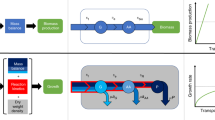Abstract
The rates of utilization of both glucose and glutamine are high in rapidly dividing ceils such as enterocytes, lymphocytes, thymocytes, tumour cells; the oxidation of both glucose and glutamine is only partial, glucose to lactate and glutamine to glutamate , alanine or aspartate ; and these partial processes are termed glycolysis and glutaminolysis respectively . Both processes generate energy and also provide precursors for important biosynthetic processes in such cells. However, the rates of utilization of precursors for macromolecular biosynthesis are very low in comparison to the rates oi partial oxidation, and energy generation per se may not be the correct explanation for high rates of glycolysis and glutaminolysis in these cells since oxidation is only partial and other fuels can be used to generate energy. Both the high fluxes and the metabolic characteristics of these two processes can be explained by application of quantitative principles of control as applied to branched metabolic pathway s (Crabtree & Newsholme, 1985). If the flux through one branch is greatly in excess of the other, then the sensitivity of the flux of the low-flux pathway to regulators is very high. Hence, it is suggested that, in rapidly dividing ceils, high rates of glycolysis and gtutaminolysis are required not for energy or precursor provision per se but for high sensitivity of the pathways involved in the use of precursors for macromolecular synthesis to specific regulators to permithigh rates of proliferation when required for example, in lymphocytes in response to a massive infection.
Similar content being viewed by others
References
Ardawi MSM & Newsholme EA (1982) Biochem. J.208, 743–748.
Ardawi MSM & Newsholme EA (1983) Biochem. J.212, 835–842.
Ardawi MSM & Newsholme EA (1984a) In: Glutamine Metabolism in Mammalian Tissues (Häussinger D & Siess H, eds), pp 235–246. Springer-Verlag, Berlin, Heidelberg.
Ardawi, MSM & Newsholme EA (1984b) Biochem. J.221, 255–260.
Ardawi MSM & Newsholme EA (1985a) Quart. Rev. Physiology (in Press).
Ardawi MSM & Newsholme EA (1985g) Biochem. J. (in press).
Brand K, Williams JF & Weidemann MJ (1984) Biochem. J.221, 471–475.
Crabtree B & Newsholme EA (1985) Curr. Topics Cellul. Regul.25, 21–76.
Hanson PJ & Parsons DA (1977) Biochem. J.166, 509–519.
Hume DA & Weidemann MJ (1979) J. Natl. Cancer Inst.62, 3–8.
Hume DA, Radik JL, Ferber E & Weidemann MJ (1978) Biochem. J.174, 703–709.
Kovacevic Z & McGivan JD (1983) Physiol. Rev.63, 547–605.
Krebs HA (1980) In: Glutamine Metabolism, Enzymology and Regulation (Mora J & Palacios R, eds), pp 319–329, Academic Press, London, New York.
Lund P (1980) FEBS Lett.117, K86-K92.
McKeehan WL (1982) Cell Biol. Intern. Reports6, 635–646.
Morgan MJ & Faik P (1981) Biosci. Rep.1, 669–686.
Newsholme EA & Leech AR (1983) Biochemistry for the Medical Sciences, Wiley, London, New York.
Parsons DS (1979) Topics in Gastroenterology7, 253–271.
Reitzer LS, Wice BM, Kennell D (1979) J. Biol. Chem.254, 2669–2676.
Roediger WEW (1982) Gastroenterology,83, 424–429.
Roos D & Loos JA (1973) Expt. Cell. Res.77, 127–135.
Warburg O (1956a) Science123, 309–314.
Warburg O (1956b) Science124, 269–270.
Watford M, Lund P & Krebs HA (1979) Biochem. J.,178, 589–596.
Williamson DH (1975) In: Early Diabetes in Early Life (Camerini-Davalos RA & Cole HS, eds), pp 195–202, Academic Press, New York.
Williamson DH & Brosnan JT (1974) Methods in Enzymatic Analysis (Bergmeyer H-U, ed), pp 2266–2302, Academic Press, New York.
Williamson DH & Buckley MB (1973) In: Inborn Errors of Metabolism (Hommes FA & Van den Bergh CJ, eds), pp 87–96, Academic Press, New York.
Williamson DH, Krebs HA, Stubbs M, Page MA, Morris HP & Weber G (1970) Cancer Res.30, 2049–2054.
Windmueller HG & Spaeth AE (1974) J. Biol. Chem.249, 5070–5079.
Zielke HR, Ozand PT, Tildon JT, Sevdalian DA & Cornblath M (1978) J. Cell. Physiol.95, 41–48.
Author information
Authors and Affiliations
Rights and permissions
About this article
Cite this article
Newsholme, E.A., Crabtree, B. & Ardawi, M.S.M. The role of high rates of glycolysis and glutamine utilization in rapidly dividing cells. Biosci Rep 5, 393–400 (1985). https://doi.org/10.1007/BF01116556
Received:
Issue Date:
DOI: https://doi.org/10.1007/BF01116556




